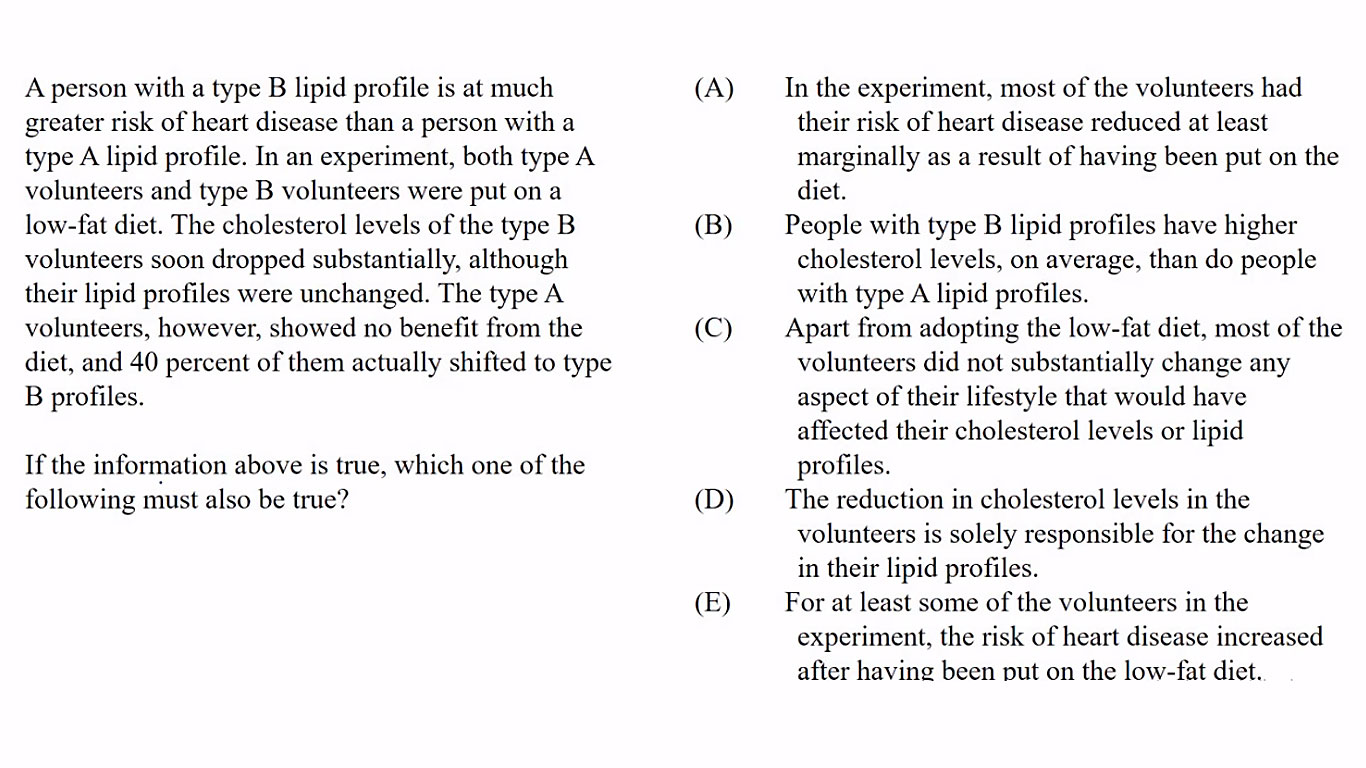Most Logical Reasoning questions use soft and fuzzy informal logic (with observations, lots of unstated assumptions, etc). Formal Logic is what a computer would do: hard, logic-following rules, like what you’ve done in this chapter. Formal logic is common in the legal field. Here’s an example:
- You were on the neighbor’s property. (Premise)
- It is against trespassing laws to be on the neighbor’s property. (Premise)
- You are therefore guilty of trespassing. (Conclusion)
Not much wiggle room there! That’s why the LSAT often tests formal logic with must be true or must be false questions. We are dealing with certainty. Certainty is explored on the LSAT with Must Be True questions.
CHALLENGE: Identify Inferences
Must Be True (MBT) questions are about 7% of Logical Reasoning questions and are identifiable through their distinctive question stems:
- Which of the following must be false?
- If the statements above are true, which of the following must also be true?
- Which of the following may be correctly inferred?
- Which of the following inferences (inference means the same thing as “must be true” on the test) is best supported by the statement made above?
Conclusions differ from inferences in that conclusions are the result of premises and inferences must be true if the premises are true. Don’t panic if that sounds complicated; we review this concept extensively in the following chapter.
How to solve
- Diagram out the statements of the argument (if you can’t get a quick grasp of it in your head).
- Make valid inferences from these statements (transitive property and contrapositive). Note any false inferences, if any, such as the Fallacy of the Converse and Fallacy of the Inverse.
- In Must be True questions you’ll find four choices that can sometimes be wrong and one that can never be wrong (that’s the correct choice!). Go through every answer choice systematically and check if it is ALWAYS true. These questions should always be tackled using the PoE (Process of Elimination) method. If you can find a reasonable situation when it is not always true, eliminate it. Gradually eliminate answer choices until you have one left.
Intro (0:01) | Ex.1 (2:17) | Ex.2 (6:24) | Ex.3 (9:02) | Trap Choices (12:24)
Register for a free demo class and a free LSAT from kaplan.
Must Be True Video Summary
kaplan
- 0:48 – To recognize if a question is a “must be true” question, look for certain language cues, such as “must be true,” “can logically be inferred,” “can be properly concluded from the information given,” “consequence of the view above is,” and “must be true except.”
- 1:14 – To solve this type of questions, look at related statements, identify the reasoning structure that connects these statements, then anticipate what the answer would be and review the answer choices.
- 1:43 – If A → B and B → C, then A → C. This is called “syllogism.”
- 2:17 – Consider the example involving “syllogisms.”
- 2:37 – Diagram the first statement as: Inspired Performance → Good Show. Diagram the next statement as: Good Show → Sophisticated Listeners; and the last statement as: Sophisticated Listener → Understand Musical Roots.
- 2:53 – Link these statements together to infer the following statement diagrams: Inspired performance → Understand Musical Roots; Inspired Performance → Sophisticated Listeners; Good Show → Understand Musical Roots; contrapositive: ~Understand Musical Roots → ~Good Show.
- 3:51 – Diagram (A) as: ~Sophisticated Listeners → ~Inspired Performance. This is the contrapositive of the inference of the first two statements.
- 4:10 – Diagram (B) as: ~Good Show → ~Understand Musical Roots. This is a negation of the inference of the last two premises. Therefore, this is incorrect.
- 4:38 – (C) can be diagrammed as: Understand Musical Roots → Inspired Performance. This is a reversal of the inference of all three statements, so this is incorrect.
- 4:58 – Diagram (D) as: ~Good Show → ~Understand Musical Roots. This is the same as (B), which is incorrect.
- 5:15 – (E) can be diagrammed as: Sophisticated Listener → Inspired Performance. This is a reversal of the inference of the first and second premises, which is incorrect.
- 5:28 – This leaves (A) as the correct answer.
Comparison Example (starts at 6:25)
- 6:25 – Consider the example involving “comparison.”
- 6:35 – The example tells us that no headache pill stops pain more quickly than Danaxil. Visualize this as: Danaxil ≤ Leading Competitor.
- 6:51 – We also know that Evelyn will be taking Danaxil and Jane will be taking its leading competitor. Infer that Evelyn’s headache pain will be relieved at least as quickly or more quickly than Jane’s.
- 7:16 – (A) contradicts the information that all headache pills can stop their headaches. Therefore, this is incorrect.
- 7:31 – (B) is not the right answer because its claim is stronger than what the information supports. We only know that it will be relieved as quickly as Jane’s or maybe faster. This answer is too strong and therefore, is incorrect.
- 8:00 – (C) gives us the weak inequality that the information provides.
- 8:12 – (D) is stronger than what the information provides. This is one of the possibilities but not the only possibility. This answer is too strong and therefore, it is incorrect.
- 8:29 – (E) contradicts the information provided to us because it says that all headache pills can stop headaches, so there’s no reason for Jane to exclusively take Danaxil to relieve her headache pain.
- 8:48 – (C) is the correct answer.
Causation Example (starts at 9:04)
- 9:04 – Consider the example involving “causation.”
- 9:30 – Visualize the connection between these statements as: Agricultural Runoff → Phosphorus Levels Doubled → Increased Plankton → Less Oxygen → Fewer Fish.
- 10:36 – Visualizing (A), it looks like the first three steps in the causal chain.
- 10:59 – (B) is out of scope because it claims that before phosphorus levels doubled in the ocean region, most fish survived in the region. But we do not know what happened before phosphorus levels doubled, so this is incorrect.
- 11:10 – (C) claims that there would be no bacteria in the ocean if agricultural runoff ceased pouring out of the river, but this is not given. It’s only a speculation about a hypothetical situation and therefore, is incorrect.
- 11:28 – (D) is not the right answer because it claims something that is stronger than the information provided.
- 11:41 – (E) is a much stronger claim than what is provided. Therefore, it is incorrect.
- 12:14 – (A) is the correct answer, which is simply a part of the given causal chain.
- 12:24 – Note: Be wary of trap answer choices that may involve the scope, logic, or degree of the statements.
B. Must Be False
The opposite of Must Be True is Must Be False. In Must Be False questions you will find four choices that are correct and one choice that can never be correct. So, you just run through the choices with Process of Elimination to knock the four workable ones and select the one answer that can never work.
Intro (0:01) | Ex.1 (1:42) | Ex.2 (7:32) | Trap Choices (12:02)
Kaplan offers six classes a week. Register for a free demo class.
Must Be False Video Summary
- 0:41 – To recognize “must be false” questions, look at the question stem and for certain phrases, such as “must be false,” “cannot be true,” and “could be true except.”
- 1:08 – Find the related statements, identify the reasoning structure that connects them, anticipate what the answer would be and navigate the answer choices carefully.
- 1:44 – Consider the given example.
- 3:09 – Diagram the first part that is true of all immoral actions as: Immoral + Public → Offend.
- 3:24 – The second statement is not presented as a relationship but since it refers to immoral actions, its diagram is: Immoral → Guilt.
- 4:20 – (A) states that some immoral actions are not accompanied by feelings of guilt. This contradicts the second relationship.
- 5:00 – (B) mentions something about when immoral actions are wrong. This choice is out of scope and thus, is incorrect.
- 5:13 – (C) does not mention anything about whether these actions are immoral actions. This choice does not meet the sufficient condition of either of the two roles and cannot contradict either of them. This is an unsupported relationship and therefore, is incorrect.
- 5:46 – (D) mentions actions that are not immoral. It does not meet the sufficient condition of either of the relationships and thus, is not the correct answer.
- 6:29 – (E) is a modified version of a reversal of the second premise. Since it deals with a reversal, it does not contradict the original idea. Therefore, this is not the correct answer.
- 7:14 – (A) is the correct answer.
Comparison Example (starts at 7:31)
- 7:31 – Consider the example regarding “comparison.”
- 8:06 – Visualize the first statement regarding ratios as: Sharks (Cartilage/Mass) > Others (Cartilage/Mass).
- 8:12 – Similarly, the second statement can be visualized as: Sharks (Resist Cancer) > Others (Resist Cancer).
- 8:22 – The third statement tells us how sharks’ cancer resistance works, but it does not say anything about a comparison between sharks and other organisms. Ignore this one since it does not help answer the question.
- 8:43 – The last statement is about patients and their response to shark cartilage compared to other treatments.
- 9:13 – Look for an answer choice that contradicts any of the premises.
- 9:20 – (A) is incorrect because it contradicts the second premise. The second premise states that sharks resist cancer better than other organisms, but the second part of this choice claims that sharks’ resistance to cancer can be tied with other organisms.
- 10:00 – (B) shows an unsupported relationship because it compares two non-shark organisms, which we can neither support nor contradict in this context. Therefore, this is not the right answer.
- 10:43 – (C) is also an unsupported relationship. Thus, this cannot be the right answer.
- 11:06 – (D) does not necessarily contradict the statements. Even though patients are responding better to the shark cartilage therapies compared to other therapies, this does not mean that they’re not responding to those other therapies. This answer is too weak and therefore, is not the right answer.
- 11:50 – (E) is out of scope since immune systems were never discussed, so this is incorrect.
- 12:00 – (A) remains as the right answer.
- 12:03 – Note: Be wary of trap answer choices that may involve the scope, logic, or degree of the statements.
Next LSAT: Sep 08/ Sep 09
Next LSAT: Sep 08/ Sep 09








